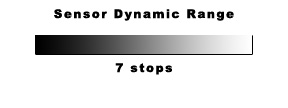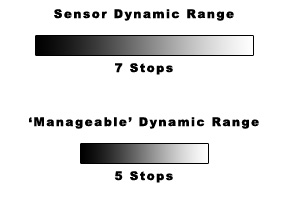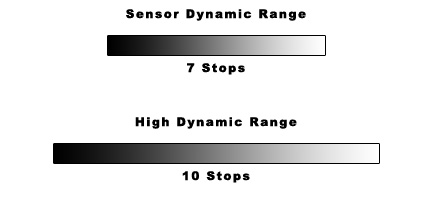In the first posting we discussed how colors are translated into three numbers in a digital camera, one for each of the three primary colors – Red, Green and Blue (RBG for short). After all, digital cameras are computers complete with processors, memory and software. We described the 8 bit color mode in which the numbers range from 0 to 255 and are used to measure and store the brightness of each color. Zero is darkest dark possible and 255 is the brightest bright possible. When all three colors are combined in equal proportions you end up with gray. If all three colors are zeros (0,0,0) you have pure black; if they are all 255s (255,255,255) you have pure white.
Camera Sensor Dynamic Range
The next step in this journey of understanding it to realize how the pixels in the camera sensor work. Recall that each pixel is really three pixels – one for each of the primary colors. While the following is an oversimplification, suffice it to say that the sensor has a built in dynamic range that can be measured in stops. That is to say, the range from the darkest darks to the brightest brights that the sensor is capable of capturing can be measured in stops. This is also true of all films. For example, the dynamic range may be as little as five stops (generally most color positive films) and as much as ten stops or more (generally the most advanced digital cameras). For the remainder of this discussion we can assume our camera has a dynamic range of 7 stops. It can be illustrated in this way….
It is worth saying a few words about what the terms “blackest black” and “whitest white” mean. From the sensor’s perspective these are the extremes of dark and light in which detail is lost. The black is just that, black. There are no shades of gray no matter how dark. It’s like looking onto a black hole and seeing nothing. Same is true with white; it is just white. There is no texture, nothing to see there either. It’s as interesting as a blank sheet of white paper. A general rule of photography is that you do not want large areas that are pure black or pure white.
Subject Dynamic Range – Manageable
But we’ve been talking about the sensor in the abstract as if we were analyzing it in a lab. Let’s talk about the camera’s sensor (or film) in the context of shooting a real photograph. The subjects we shoot will have their own dynamic ranges (unless we’re shooting that black hole or sheet of white paper above). Interesting subjects will have shadows, highlights, and all the tones in between
The situation we like to encounter the most is when the subject has a dynamic range that fits within the dynamic range of the sensor of film. We can illustrate it this way….
This subject has a dynamic range of five stops and can be thought of as a “manageable dynamic range.” There are a lot of situations in nature where manageable dynamic ranges are encountered so it’s not entirely unreasonable. In this case the darkest darks and the brightest brights both fall within the dynamic range of the sensor. Notice that if you superimpose the subject dynamic range on top of that of the sensor the darkest parts of the subject will fall in the gray but not the black area of the sensor’s range. Likewise, the brightest parts of the subject fall in the light parts but not the pure white part of the range. With this subject we are able to capture detail in both the shadows and the highlights.
Subject Dynamic Range – HDR
But alas, not all subjects are so cooperative. In many outdoor shooting situations we encounter subjects with dynamic ranges that exceed that of the sensor. A subject with a 10 stop dynamic range looks like this….
In an HDR situation, much of the shadows fall below the darkest dark of the sensor range and the highlights fall above the brightest brights. Any parts of the subject that fall outside the sensor’s dynamic range are clipped. So we have shadow and highlight clipping; that is, pure blacks in the shadows and pure whites in the highlights. This can lead to some very unsatisfying results.
Real World Dynamic Range
Let’s say a few words about actual dynamic ranges encountered in nature. One fairly useful generalization is that manageable dynamic ranges are usually encountered in early morning and late afternoon. Besides the other reasons to shoot at this time of day such as the wonderfully warm light of sunrise and sunset, the dynamic ranges of subjects usually fall well within the capabilities of the sensor or film.
Photographers abandon the grand vistas on overcast days and become more quiet, introspective and sensitive. Why? Well a major reason is that the dynamic range of great landscapes is usually way beyond the sensor’s range. To compensate for that, photographers shoot intimate landscapes that exclude the sky and focus on the wonderfully saturated colors of the vegetation.
On the other hand, there are numerous situations that create HDR challenges. A Southern California live oak grove in mid-day is a beautiful, refreshing place. I’m always tempted to lay down in the leaves and take a nap. The arching arms of the oaks shelter the leaf covered earth in deep shade. Little pools of sunlight pierce the canopies to leave a beautiful dappled effect the forest floor. It’s absolutely wonderful. But it cannot be photographed using conventional means. The dappled spots on the floor are in direct sunlight while the rest of the scene is in deep, deep shade. The dynamic range may be ten, twelve or more stops. This is one HDR situation that has forced many photographers of the past to simply walk on.
Thunder storms with towering cumulus nimbus clouds exploding in the brilliant blue sky but with dark, tumultuous downpours of rain at their bottoms are also HDR situations. Photographers also face this challenge in slot canyons. A mountain lake after sunset but with brilliant alpine glow on the peak that towers above is another example
The list of situations where HDR subjects poses challenges goes on and on. Traditional photographers (read pre-digital) had to develop techniques for coping with HDR, many of them being just as valid in either discipline. We’ll talk about those in the next posting.
Other Postings in this Series
To continue on with this series read
(1201)




3 thoughts on “High Dynamic Range #2 (HDR)”